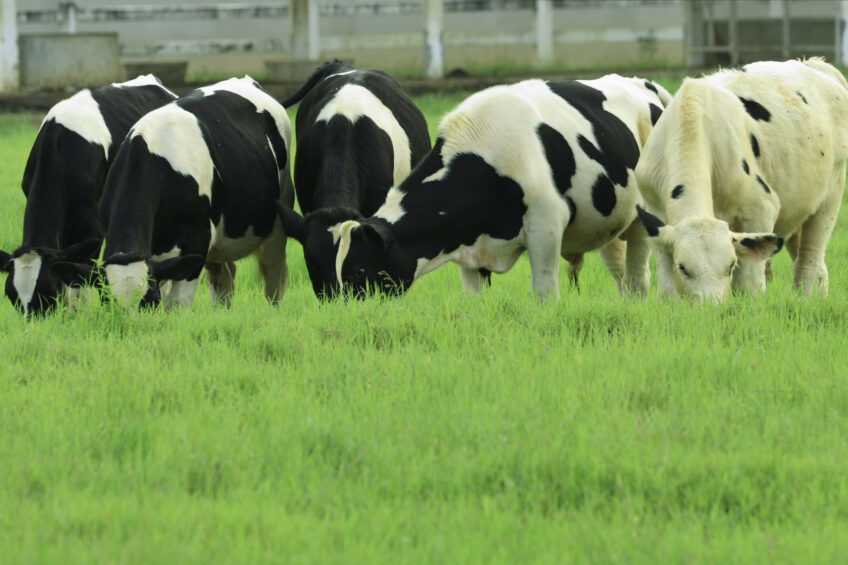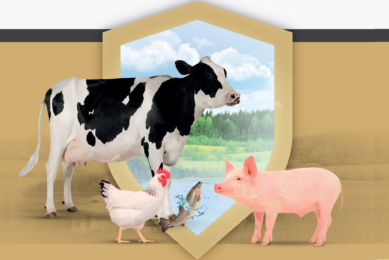From the field to the cow’s health: Mycotoxin-contaminated forage

Silage is a good source of fibre, with the added value of high energy and high digestibility for dairy cows. However, mycotoxins can have a detrimental effect on the quality and value.
Over the past 3 decades, milk productivity has improved by a considerable margin thanks to higher nutritive values, increased digestibility, higher intakes and efficiency of forages. Forage generally makes up 40–80% of the average dairy herd’s diet. However, recently dairy farms have come under pressure due to severe droughts, low milk prices and ever-increasing input costs. In total mixed ration (TMR) feeding systems, an average of 70% input costs will be allocated to feed. In these tough times, livestock farmers and nutritionists have realised the true value of having maize silage as part of a fodder bank.
Only a few farmers had sufficient amounts of silage. It is no secret that silage is a good source of fibre, with the added value of high energy and high digestibility. It is inevitable that nutrient quality will vary from one year to the next, largely dependent on the climate. The climate also determines the level of mycotoxins, which will have a dramatic effect on the ultimate feeding value for the animal.
Occurrence and concentration
In the field, forages are naturally in contact with various fungi, the most common one being Fusarium. Fusariose is a common disease found on cereals, often caused by F. graminearum, F. culmorum, F. poae and F. avenaceum. As for all fungi, Fusarium growth depends on moisture levels (22 to 25% humidity in the plant) and temperature (>15°C). Certain cultivation methods such as crop rotation have been identified for their impact on Fusarium development.
Growing maize on the same land for consecutive years will increase the risk of deoxynivalenol (DON) development in the crop (Bateman et al., 2007), as the crop residues are also contaminated by Fusarium and carry the fungi from one year to the next. That is also why no-till farming significantly increases the risk of Fusarium development, as crop residues will not be ploughed under and therefore remain on the surface, which results in contamination of the following crop (Blandino et al., 2012; Ono et al., 2011).
Selecting varieties resistant to Fusarium helps to control the risk on the crop. However, this criterion is not yet well documented on maize seeds, as it is difficult to evaluate (Xiang et al., 2010; Martin et al., 2011). Field application of fungicides is uncommon in maize due to the height of the plants. Consequently, the risk of Fusarium development on maize is higher than on other cereals, but fungicides can still be efficient in the reduction of mycotoxins (De Curtis et al., 2011).
Variability in production
The fungi itself does not normally pose a threat to the animal, but Fusarium produces mycotoxins in stress conditions. All factors that alter fungal development can initiate the production of these secondary metabolites, also known as mycotoxins. Changes in humidity can also affect the production of mycotoxins. Forages are often contaminated with Fusarium mycotoxins such as trichothecenes (DON), zearalenone (ZEN) and fumonisins, with variable levels of contamination depending on climate and cultivation methods. Mycotoxin occurrence and concentration in forages are variable from year to year, as a result of the annual variation in weather conditions and plant stresses known to affect mycotoxin formation (Doohan et al., 2003). The quality of silage preservation and general management will also have an impact on the development of Fusarium and storage mycotoxins (aflatoxins, ochratoxins).
Detoxification by rumen microbes
It has long been accepted that rumen microbes can detoxify mycotoxins. However, in certain studies involving dairy cows, scientists found that the capacity for mycotoxin detoxification in the dairy cow’s rumen is lower than believed.
Heinz-Kiessling et al. (1984) showed that the efficacy of detoxification is not the same for all mycotoxins. Diacetoxyscirpenol (DAS), trichothecene mycotoxin (T-2), ochratoxin and ZEN are partially converted, whereas in this study no degradation was noticed for DON and aflatoxin B1. Other studies measured a partial degradation of DON into de-epoxy deoxynivalenol (DOM-1), which is a less toxic form (Prelusky et al., 1987 and Coté et al., 1986). Heinz-Kiessling et al. (1984) also showed that the decrease of ZEN was the result of a reduction to zearalenol, and mainly (90%) to α-zearalenol, which is 3 to 4 times more oestrogenic than the parent compound. Fumonisins are not altered in the rumen (Pfohl et al., 1999). Heinz-Kiessling proved that protozoa are invariably more active than bacteria in the detoxification process of certain trichothecens, but they are also more sensitive to these trichothecens than bacteria (Westlake et al., 1987).
Ruminal patterns studied
A German study (Keese et al., 2008) investigated the ruminal patterns influenced by the proportion of concentrate in the feed ration, with and without Fusarium toxin contamination of the diet. Feeding a TMR with 50% concentrate and a mean DON concentration of 5.3mg/kg dry matter (DM) to 13 German Holstein cows in early lactation (myco group) resulted in alterations in the ruminal fermentation patterns. Alteration of the volatile fatty acids balance was followed by a drop in pH values, which is critical for developing subacute acidosis. This could indicate a switch in the microbial community due to direct and/or indirect effects of the Fusarium infection on ruminal microbes.

Mycotoxin Regulation Tool:
This interactive tool gives you the regulations for mycotoxins per commodity per country.
Effect on cattle
Fusarium mycotoxins exert their effects via 3 primary mechanisms in dairy cattle:
- The first impact on animal health is an increase in immunodepression, described by Surai and Dvorska in 2005. In 2009, Korosteleva et al., concluded that Fusarium mycotoxins can decrease certain cellular aspects of the immune function in dairy cattle, while stimulating a primary humoral response to specific antigens.
- The second impact of Fusarium mycotoxins (mainly trichothecenes) is a reduction in the amount of nutrients available for use by the animal due to lower feed intake, and by irritation of the digestive tract and reduction in villi height (Pinton et al., 2012).
- The third impact is the direct oestrogenic effects on reproductive performance by ZEN and its metabolites (Klang et al., 1978).
Conclusion
To the dairy farmer, the clinical or subclinical losses in performance, the increase in incidence of disease and reduced reproductive performance are of great economic importance. Therefore, it is vital to detect and protect cows from mycotoxin contamination to avoid such economic losses.
This article has been reprinted from AFMA Matrix (January 2017). References available from the author at email: jwvanniekerk08@gmail.com.
Join 13,000+ subscribers
Subscribe to our newsletter to stay updated about all the need-to-know content in the dairy sector, two times a week.











